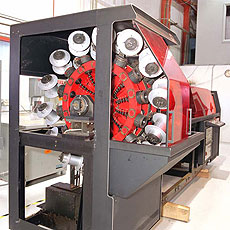A collaboration of national laboratories, universities, and industry may soon begin testing a new material that could help to revolutionize the superconducting magnet field.
The US Department of Energy is providing $4 million in Recovery Act funds to the Very High Field Superconducting Magnet Collaboration to test BSCCO2212, a bismuth-based material that may allow scientists to create high-field superconducting magnets that could achieve more than twice the strength of existing magnets. Fermilab will manage $1.5 million of the new funds and has already started making cable to test the new material.
Both the Tevatron and the Large Hadron Collider at CERN use superconducting magnets made out of niobium-titanium to steer beams of particles in accelerators. The Tevatron’s magnets have a field of 4 Tesla, and the LHC’s magnets can achieve 8 Tesla. Recent tests on alternative materials, such as niobium-tin, reached a magnetic field of 13 Tesla.
The development of high-field magnets that can exceed 50 Tesla could provide a path forward for a possible muon collider at Fermilab.
Led by spokesperson David Larbalestier of Florida State University, collaboration members believe that BSCCO2212 is the answer. But because it has a completely different structure than niobium, it comes with a whole new set of challenges, namely that it breaks very easily.
“In order to turn it into a superconductor, we heat the BSCCO2212 up to 800 degrees,” said Fermilab physicist Alvin Tollestrup. “The trouble is that it becomes more or less a ceramic. If you bend it, it breaks.”
In the project’s first phase, Fermilab will purchase the bismuth-based material from US vendors to conduct cabling and coil studies. Collaboration members will research the material’s properties in detail and determine how much they can stretch it and whether they can make it into cables. Collaboration member institutions include: Brookhaven National Laboratory, Fermilab, Florida State University, Lawrence Berkeley National Laboratory, Los Alamos National Laboratory, National Institute of Standards and Technology and Texas A&M University.
In addition, collaboration members will partner with businesses to encourage industrial fabrication of high-field magnets, an effort that could result in cutting edge technologies for other applications. Fermilab’s development and construction of the first reliable superconducting accelerator magnets for the Tevatron approximately 30 years ago led to industrial fabrication that resulted in such applications as medical MRI systems.
“Superconducting magnets have been one of the main keys for enabling technology,” Tollestrup said. “There is no doubt that there are uses both in high-energy physics and areas of industry and medicine that will require high-field magnets.”







